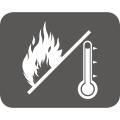The product complies with the European Directive 89/686, notably regarding ergonomics, innocuousness, comfort and with standards :
SPLIT COWHIDE WELDER’S GLOVE – 15-CM CUFF
Cowhide split leather. 15 cm cuff. American assembly. Length: 35 cm.
| Reference |
pcb |
Colour |
Size |
| DPTC71510 |
60 |
Grey |
10 |
EN420:2003+A1:2009 General requirements - 4 Dexterity (from 1 to 5)
• Conform to harmlessness (pH, chrome VI levels, etc…).
• Conform to the size charts (see chart on below).
• Pass the dexterity test.
• Conform to the labelling, information and identification instructions.
EN388:2003 Protective gloves against mechanical Risks (Levels obtained on the palm) - 2 Resistance to abrasion (from 1 to 4)
- 1 Resistance to cutting (from 1 to 5)
- 4 Resistance to tear (from 1 to 4)
- 2 Resistance to puncture (1 to 4)
The EN388 standard applies to all types of protective gloves with respect to physical and mechanical aggression from abrasion, cutting from slicing, perforation and tearing.
ABRASION RESISTANCE (1 à 4): Number of cycles required to damage the sample at constant speed.
RESISTANCE TO CUTTING WITH A BLADE (1 à 5): Number of cycles required to cut the sample at constant speed.
RESISTANCE TO TEARING (1 à 4): Maximum force required to tear the sample.
RESISTANCE TO PERFORATION (1 à 4): Force required to pierce the sample with a standardized punch.
EN407:2004 Protective gloves against Heat & Fire risks (X = Unrealized test) - 4 Resistance to flammability (from 1 to 4)
- 1 Resistance to contact heat (from 1 to 4)
- 3 Resistance to convective heat (from 1 to 4)
- x Resistance to radiant heat (from 1 to 4)
- 4 Resistance to small projections of liquid metal (from 1 to 4)
- x Resistance to large projections of molten metal (from 1 to 4)
The EN407 standard specifies the test methods, the general requirements, the thermal performance and the labelling of gloves to protect from heat and fire.
It applies to all gloves which must protect hands from heat and/or flames in any one or several of the following forms: fire, contact heat, convective heat, radiating heat, small spray of molten metal or large spray of melting metal.
RESISTANCE TO FLAMMABILITY (1 to 4): Time during which the material remains lighted and continues to be consumed after the ignition source has been eliminated.
RESISTANCE TO CONTACT HEAT (1 to 4): Temperature (within the range of 100°C to 500°C) at which the person wearing the gloves will not feel any pain (for a period of at least 15 seconds).
RESISTANCE TO CONVECTIVE HEAT (1 to 4): Time during which the glove is able to delay the transfer of the heat of a flame.
RESISTANCE TO RADIATING HEAT (1 to 4): Time required to raise to a given temperature level.
RESISTANCE TO SMALL MELTING METAL SPRAY (1 to 4): Amount of spray required to raise the glove to a certain temperature.
RESISTANCE TO LARGE MELTING METAL SPRAY (1 to 4): Amount of spray required to cause damage.
EN12477:2001/A1:2005 Protective gloves for welders - A Welding - Other welding processes - less dexterity - Type A
- Welding - High dexterity required Type B
Requirements and test methods for gloves used for manual welding of metals, for cutting and related techniques.
Welder gloves are ranked in two types: B when great dexterity is required, and A for other welding processes.

